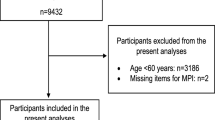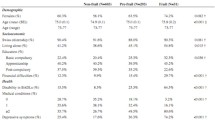Abstract
Purpose
Although frailty was originally a medical concept, nowadays more and more researchers are convinced of its multidimensional nature, including a psychological and social domain of frailty as well as a physical domain. The objective of this study was to test the hypothesis that the prediction of quality of life by physical frailty components is improved by adding psychological and social frailty components.
Methods
This cross-sectional study was carried out with a sample of Dutch citizens. A total of 1,031 people aged 65 years and older completed a Web-based questionnaire containing the Tilburg Frailty Indicator for measuring physical, psychological, and social frailty, and the WHOQOL-BREF for measuring four quality of life domains (physical health, psychological, social relations, environmental).
Results
The findings show that the prediction of all quality of life domains by eight physical components of frailty was improved after adding four psychological and three social frailty components. The psychological frailty component ‘feeling down’ significantly improved the prediction of all four quality of life domains, after controlling for the effects of background characteristics and all other frailty components.
Conclusion
This study emphasizes the importance of a multidimensional assessment of frailty in the prediction of quality of life in older people.
Similar content being viewed by others
References
Boyd, C. M., Xue, Q. L., Simpson, C. F., Guralnik, J. M., & Fried, L. P. (2005). Frailty, hospitalization, and progression of disability in a cohort of disabled older women. The American Journal of Medicine, 118(11), 1225–1231.
Fried, L. P., Tangen, C. M., Walston, J., et al. (2001). Frailty in older adults: Evidence for a phenotype. Journal of Gerontology Medical Sciences, 56(3), M146–M156.
Ravaglia, G., Forti, P., Lucicesare, A., Pisacane, N., Rietti, E., & Patterson, C. (2008). Development of an easy prognostic score for frailty outcomes in the aged. Age and Ageing, 37(2), 161–166.
Jones, D. M., Song, X., & Rockwood, K. (2004). Operationalizing a frailty index from a standardized comprehensive geriatric assessment. Journal of the American Geriatrics Society, 52(11), 1929–1933.
Rockwood, K., Song, X., MacKnight, C., et al. (2005). A global clinical measure of fitness and frailty in elderly people. Canadian Medical Association Journal, 173(5), 489–495.
Song, X., Mitnitski, A., & Rockwood, K. (2010). Prevalence and 10-year outcomes of frailty in older adults in relation to deficit accumulation. Journal of the American Geriatrics Society, 58(4), 681–687.
Chang, Y. W., Chen, W. L., Lin, F. G., et al. (2012). Frailty and its impact on health-related quality of life: A cross-sectional study on elder community-dwelling preventive health service users. PLoS ONE,. doi:10.1371/journal.pone.0038079.
Bilotta, C., Bowling, A., Case, A., et al. (2010). Dimensions and correlates of quality of life according to frailty status: a cross-sectional study on community-dwelling older adults referred to an outpatient geriatric service in Italy. Health and Quality of Life Outcomes,. doi:10.1186/1477-7525-8-56.
Masel, M. C., Ostir, G. V., & Ottenbacher, K. J. (2010). Frailty, mortality, and health-related quality of life in older Mexican Americans. Journal of the American Geriatrics Society, 58(11), 2149–2153.
Levers, M. J., Estabrooks, C. A., & Ross Kerr, J. C. (2006). Factors contributing to frailty: Literature review. Journal of Advanced Nursing, 56(3), 282–291.
Markle-Reid, M., & Browne, G. (2003). Conceptualizations of frailty in relation to older adults. Journal of Advanced Nursing, 44(1), 58–68.
Gobbens, R. J., Luijkx, K. G., Wijnen-Sponselee, M. T., & Schols, J. M. (2010). Toward a conceptual definition of frail community dwelling older people. Nursing Outlook, 58(2), 76–86.
Hogan, D. B., MacKnight, C., & Bergman, H. (2003). Models, definitions, and criteria of frailty. Aging Clinical and Experimental Research, 15(3 Suppl), 1–29.
Gobbens, R. J., Luijkx, K. G., Wijnen-Sponselee, M. T., & Schols, J. M. (2010). Towards an integral conceptual model of frailty. The Journal of Nutrition, Health & Aging, 14(3), 175–181.
The WHOQOL Group. (1995). The World Health Organization Quality of Life assessment (WHOQOL): Position paper from the World Health Organization. Social Science & Medicine, 41(10), 1403–1409.
Lee, T. W., Ko, I. S., & Lee, K. J. (2006). Health promotion behaviors and quality of life among community-dwelling elderly in Korea: A cross-sectional survey. International Journal of Nursing Studies, 43(3), 293–300.
Paskulin, L., Vianna, L., & Molzahn, A. E. (2009). Factors associated with quality of life of Brazilian older adults. International Nursing Review, 56(1), 109–115.
Lubetkin, E. I., Jia, H., Franks, P., & Gold, M. R. (2005). Relationship among sociodemographic factors, clinical conditions, and health-related quality of life: Examining the EQ-5D in the U.S. general population. Quality of Life Research, 14(10), 2187–2196.
Raphael, D., Brown, I., Renwick, R., Cava, M., Weir, N., & Heathcote, K. (1997). Measuring the quality of life of older persons: A model with implications for community and public health nursing. International Journal of Nursing Studies, 34(3), 231–239.
Hilleras, P. K., Jorm, A. F., Herlitz, A., & Winblad, B. (2001). Life satisfaction among the very old: A survey on a cognitively intact sample aged 90 years or above. The International Journal of Aging and Human Development, 52(1), 71–90.
Netuveli, G., & Blane, D. (2008). Quality of life in older ages. British Medical Bulletin, 85, 113–126.
Hunger, M., Thorand, B., Schunk, M., et al. (2011). Multimorbidity and health-related quality of life in the older population: results from the German KORA-age study. Health and Quality of Life Outcomes,. doi:10.1186/1477-7525-9-53.
Rijken, M., van Kerkhof, M., Dekker, J., & Schellevis, F. G. (2005). Comorbidity of chronic diseases: Effects of disease pairs on physical and mental functioning. Quality of Life Research, 14(1), 45–55.
Fortin, M., Bravo, G., Hudon, C., et al. (2006). Relationship between multimorbidity and health-related quality of life of patients in primary care. Quality of Life Research, 15(1), 83–91.
Gobbens, R. J., van Assen, M. A., Luijkx, K. G., Wijnen-Sponselee, M. T., & Schols, J. M. (2010). The Tilburg Frailty Indicator: Psychometric properties. Journal of the American Medical Directors Association, 11(5), 344–355.
Gobbens, R. J., van Assen, M. A., Luijkx, K. G., & Schols, J. M. (2012). The predictive validity of the Tilburg Frailty Indicator: Disability, health care utilization, and quality of life in a population at risk. The Gerontologist, 52(5), 619–631.
Lin, C. C., Li, C. I., Chang, C. K., et al. (2011). Reduced health-related quality of life in elders with frailty: A cross-sectional study of community-dwelling elders in Taiwan. PLoS ONE,. doi:10.1371/journal.pone.0021841.
Ware, J. E, Jr, & Sherbourne, C. D. (1992). The MOS 36-item short-form health survey (SF-36). Conceptual framework and item selection. Medical Care, 30(6), 473–483.
Pilotto, A., Rengo, F., Marchionni, N., et al. Comparing the prognostic accuracy for all-cause mortality of frailty instruments: A multicentre 1-year follow-up in hospitalized older patients. PLoS One, doi:10.1371/journal.pone.0029090.
Andrew, M. K., Mitnitski, A. B., & Rockwood, K. (2008). Social vulnerability, frailty and mortality in elderly people. PLoS ONE,. doi:10.1371/journal.pone.0002232.
Treurniet, H. F., Hoeymans, N., Gijsen, R., Poos, M. J., van Oers, J. A., & Thien, W. M. (2005). Health status and the challenges for prevention in the Netherlands. Public Health, 119(3), 159–166.
Central Committee on Research inv. Human Subjects. (2010). Does your study have to be reviewed? http://www.ccmo-online.nl (Home > For investigators > Review step plan RC > WMO) Accessed June 15, 2010.
Metzelthin, S. F., Daniels, R., van Rossum, E., de Witte, L., van den Heuvel, W. J., & Kempen, G. I. (2010). The psychometric properties of three self-report screening instruments for identifying frail older people in the community. BMC Public Health,. doi:10.1186/1471-2458-10-176.
WHOQOL Group. (1998). Development of the World Health Organization WHOQOL-BREF quality of life assessment. Psychological Medicine, 28(3), 551–558.
Skevington, S. M., Lotfy, M., & O’Connell, K. A. (2004). The World Health Organization’s WHOQOL-BREF quality of life assessment: Psychometric properties and results of the international field trial. A report from the WHOQOL group. Quality of Life Research, 13(2), 299–310.
Kalfoss, M. H., Low, G., & Molzahn, A. E. (2008). The suitability of the WHOQOL-BREF for Canadian and Norwegian older adults. European Journal of Ageing, 5(1), 77–89.
Hawthorne, G., Herrman, H., & Murphy, B. (2006). Interpreting the WHOQOL-BREF: Preliminary population norms and effect sizes. Social Indicators Research, 77, 37–59.
Cohen, J. (1988). Statistical power analysis for the behavioral sciences (2nd ed.). Hillsdale: Lawrence Erlbaum Assoc Inc.
Bowling, A. (2009). The psychometric properties of the older people’s quality of life Questionnaire, compared with the CASP-19 and the WHOQOL-OLD. Current Gerontology and Geriatrics Research,. doi:10.1155/2009/298950.
Puts, M. T., Lips, P., & Deeg, D. J. (2005). Static and dynamic measures of frailty predicted decline in performance-based and self-reported physical functioning. Journal of Clinical Epidemiology, 58(11), 1188–1198.
Bergman, H., Béland, F., Karunananthan, S., Hummel, S., Hogan, D., & Wolfson, C. (2004). English translation of article published in ‘Gerontologie et société’. Dévelopment d’un cadre de travail pour compendre et étudier la fragilité. Gérontologie et société, 109, 15–29.
Fillit, H., & Butler, R. N. (2009). The frailty identity crisis. Journal of the American Geriatrics Society, 57(2), 348–352.
Ten Doesschate, M. C., Koeter, M. W., Bockting, C. L., & Schene, A. H. (2010). Health related quality of life in recurrent depression: A comparison with a general population sample. Journal of Affective Disorders, 120(1–3), 126–132.
Penninx, B. W., Deeg, D. J., van Eijk, J. T., Beekman, A. T., & Guralnik, J. M. (2000). Changes in depression and physical decline in older adults: A longitudinal perspective. Journal of Affective Disorders, 61(1–2), 1–12.
Puts, M. T., Shekary, N., Widdershoven, G., Heldens, J., Lips, P., & Deeg, D. J. (2007). What does quality of life mean to older frail and non-frail community-dwelling adults in the Netherlands? Quality of Life Research, 16(2), 263–277.
Gabriel, Z., & Bowling, A. (2004). Quality of life from the perspectives of older people. Ageing & Society, 24(5), 675–691.
Nicholson, C., Meyer, J., Flatley, M., & Holman, C. (2012). The experience of living at home with frailty in old age: A psychosocial qualitative study. International Journal of Nursing Studies,. doi:10.1016/j.ijnurstu.2012.01.006.
Bowling, A., Seetai, S., Morris, R., & Ebrahim, S. (2007). Quality of life among older people with poor functioning. The influence of perceived control over life. Age and Ageing, 36(3), 310–315.
Low, G., & Molzahn, A. E. (2007). Predictors of quality of life in old age: A cross- validation study. Research in Nursing & Health, 30(2), 141–150.
Holmes, S. (2009). Methodological and ethical considerations in designing an Internet study of quality of life: A discussion paper. International Journal of Nursing Studies, 46(3), 394–405.
Statline. Bevolking: geslacht, leeftijd en burgerlijke staat, 1 januari. http://www.statline.cbs.nl. Accessed November 14, 2012.
Statistics Netherlands. Population pyramid [fact sheet]. http://www.cbs.nl/en-GB/menu/themas/bevolking/cijfers/extra/piramide-fx.htm?Languageswitch=on. Accessed November 13, 2012.
Gobbens, R. J., & van Assen, M. A. (2012). Frailty and its prediction of disability and health care utilization: The added value of interviews and physical measures following a self-report questionnaire. Archives of Gerontology and Geriatrics, 55(2), 369–379.
Van Campen, C. (2011). Frail older persons in the Netherlands. The Hague: The Netherlands Institute for Social Research.
Pialoux, T., Goyard, J., & Lesourd, B. (2012). Screening tools for frailty in primary health care: A systematic review. Geriatrics and Gerontology International, 12(2), 189–197.
Fall, M., Walters, S., Read, S., et al. (1997). An evaluation of a nurse-led ear care service in primary care: Benefits and costs. British Journal of General Practice, 47(424), 699–703.
Gallagher, M., Huddart, T., & Henderson, B. (1998). Telephone triage of acute illness by a practice nurse in general practice: Outcomes of care. British Journal of General Practice, 48(429), 1141–1145.
Acknowledgments
Authors would like to thank René Schalk for collecting and making available the data.
Conflict of interest
None declared.
Author information
Authors and Affiliations
Corresponding author
Appendix
Rights and permissions
About this article
Cite this article
Gobbens, R.J.J., Luijkx, K.G. & van Assen, M.A.L.M. Explaining quality of life of older people in the Netherlands using a multidimensional assessment of frailty. Qual Life Res 22, 2051–2061 (2013). https://doi.org/10.1007/s11136-012-0341-1
Accepted:
Published:
Issue Date:
DOI: https://doi.org/10.1007/s11136-012-0341-1




